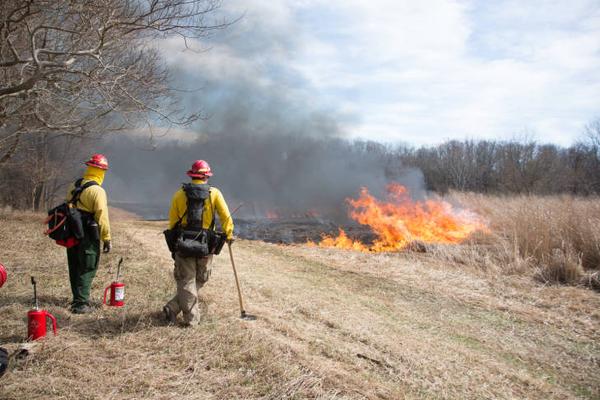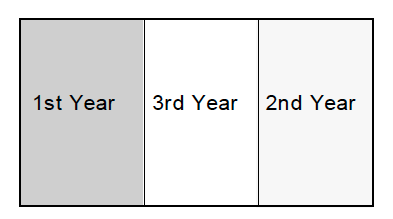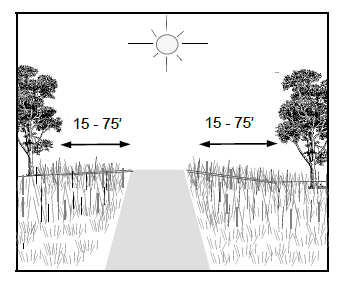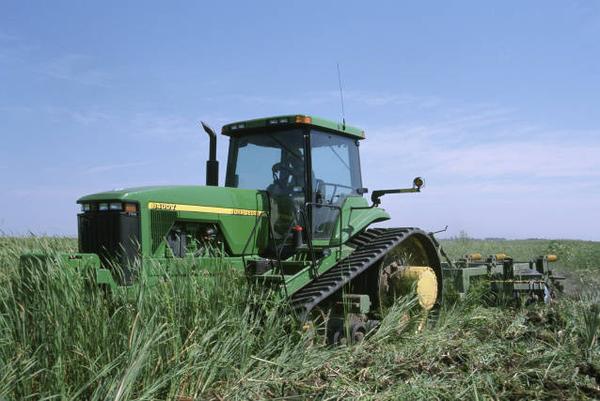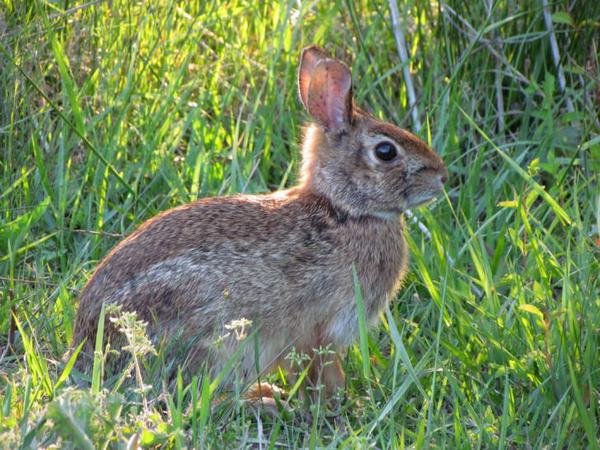Herbaceous plants are plants that have non-woody stems, including grasses, sedges, rushes, ferns, and forbs. Forbs are broad-leaf plants often referred to as wildflowers or weeds. Annual herbaceous plants live for only one year, whereas perennials live for multiple years. Herbaceous plants, especially grasses and forbs, are valuable sources of food and cover for many wildlife species, including:
|
Northern bobwhite quail |
Ruffed grouse |
|
Eastern box turtle |
Ground-nesting birds |
|
Wild turkey |
White-tailed deer |
|
Cottontail rabbits |
Mice and voles |
|
Snakes |
Butterflies |
Grasses are more important as cover and rarely are an important food source; on the other hand, forbs provide critical foods for a wide range of wildlife species (e.g., provide forage for deer and rabbits, produce seeds for bobwhite quail, harbor invertebrates for turkey poults). The availability of grasses and forbs may particularly be a limiting factor to forest-dwelling wildlife. Dense cover of overstory trees casts shade on the ground, prohibiting growth of herbaceous plants, which in turn eliminates critical food and cover for many species of wildlife.
Herbaceous plants occur across a range of plant community types (e.g., woodland, streamside forest, prairie, crop field margins) and include species with a wide range of moisture and light requirements. The frequency, timing, and extent of management practices have substantial influence on the types of species and coverage of herbaceous plants that will be present on a property.
Maintain Herbaceous Plants in Openings
Early successional openings that are free of trees contain dense herbaceous cover because of the extensive sunlight reaching the ground. These openings ideally are dominated by forbs with a lesser extent of grasses and patches of shrubs or tree sprouts. Early successional openings provide excellent food and cover for rabbits, quail, deer, and many songbirds. However, establishing and maintaining these openings can be time-consuming and costly. Hence, openings should be maintained on log decks, abandoned fields, and other unused areas adjacent to woodlands before creating new clearings. Non-native grasses (e.g., tall fescue and bermudagrass) in pastures should be removed via herbicide treatments before initiating other management activities; these grasses grow densely, restrict animal movements, and reduce forb cover.
The following methods provide cost-effective maintenance for these openings:
Mowing and Brush Chopping
Periodic mowing temporarily reduces woody vegetation that naturally overtakes abandoned fields and pastures. Best results are achieved using a rotary mower pulled by a tractor. Mowing typically is the least desirable form of disturbance because animals, including nests and young, commonly are killed by the mower blades. Mowing also promotes a buildup of grass thatch that limits bare ground, reduces forb coverage, and restricts animal movement.
Disking
Disking tends to promote more annual herbaceous plants than mowing because bare soil is exposed and more forb seeds can become established. Unlike farming operations, disking for wildlife is not aimed at uprooting and turning under all existing plant matter. Vary the disking intensity to rejuvenate existing stems and expose bare soil for plant germination. Plant response to disking will vary by season, and late winter disking tends to provide the best results with the shortest-term reduction in plant cover.
Prescribed Burning
Prescribed burning is the least costly, most versatile wildlife management tool. In early successional openings and in open woodland, prescribed fire increases the yield and quality of herbaceous plants, especially legumes. Prescribed fire conducted on a one-to-three-year interval favors herbaceous plants by exposing soil for germination, releasing nutrients, and reducing shade from young trees and shrubs.
Rotating management disturbances such as disking or burning promotes diversity of food and cover in a small area and allows wildlife a place to escape during the short time after each management action reduces vegetation cover (Figure 1). Habitat components like food and cover in close proximity promote the health and survival of young quail and other early successional wildlife. The figure below illustrates a typical three-year rotation system that provides forbs and grasses adjacent to older protective cover.
Selective Herbicide Treatment
Herbicides are one of the most effective and labor saving methods of managing the plant community in openings, including reductions in undesirable woody sprouts or non-native grasses and forbs. Selective spraying, wicking, or broadcast boom applications can maintain desired herbaceous plants. Consult with your local extension agent, wildlife biologist, or pesticide supplier for recommendations on the appropriate herbicide for your situation and local conditions. Always follow label directions.
Daylighting
Herbaceous strips may be created along existing fire lines, old woods roads, utility rights-of-way, and haul or skid roads. On woodland roads or similar strip openings, “daylight” or remove trees to a width that permits full sunlight to reach the ground. The objective is to have herbaceous cover with patches of woody cover along the road margins while also allowing the road to dry out more rapidly (Figure 2).
Establishing Herbaceous Plants
Examples of Herbaceous Plants Beneficial to Wildlife
|
Forbs
|
Grasses
|
|---|---|
| Partridge Pea
|
Big bluestem
|
| Thoroughwort and Boneset (Eupatorium)
|
Indiangrass
|
| Pokeweed
|
Broomsedge
|
| Roundhead lespedeza
|
Switchgrass
|
| Goldenrod (Solidago)
|
Atlantic coastal panicgrass
|
| Wild blue indigo
|
Foxtail grass
|
| Ragweed
|
Plumegrass (Saccharum)
|
| Beggarlice (Desmodium)
|
Low panicgrass (Dicanthelium)
|
| Tall coreopsis
|
Virginia wild rye
|
| Joe-Pye weed
|
Carolina geranium
|
| Common milkweed
|
|
| Butterflyweed
|
|
| Blackberry | |
| Narrowleaf mountainmint |
Planting generally is not required to establish a high quality early successional plant community. In forest, all that is required is to remove some or most of the competing overstory tree cover, especially when followed by prescribed burning. In pasture, all that is required is to kill the perennial non-native grasses. In cropland, all that is required is to allow the area to grow up in fallow vegetation comprised of grasses and forbs. Sometimes planting may be warranted in cropland that has been managed intensively for an extended period. In the case that plating is required, consider target wildlife species, soil moisture, soil types, and planting season when choosing what to plant. Always soil test and prepare the seedbed before establishment. Most forest sites are acidic and will require lime and phosphorus. In the absence of a soil test, apply 50 - 100 lbs. of lime per 1,000 square feet. Apply 10 lbs. of 10-10-10 fertilizer per 1,000 square feet in spring and fall for best results.

Grasslands and other early successional communities attract a variety of wildlife and birds.
Liessa Bowen CC BY-NC-SA 4.0
References
Thinning Pine Stands, WON-13
Forest Stewardship with Hand-Applied Herbicides, AG-530
Prescribed Fire to Improve Wildlife Habitat, AG-630
J.M., and Harper, C.A. 2018. Renovating Native Warm-season Grass Stands for Wildlife. Purdue Extension. FNR-548-W. 27 pages.
C.A. 2016. A Guide to Wildlife Food Plots and Early Successional Plants. Knoxville, TN. 446 pages. ISBN-13: 978-0692592632.
C.A. 2017. Managing Early Successional Plant Communities for Wildlife in the Eastern US. Knoxville, TN. 91 pages. ISBN 978-0-692-90231-8.
C.A. 2017. A Quick Guide for Landowners Managing Old-fields for Wildlife. UT Extension. PB 1855. 13 pages.
Working With Wildlife Series Links
North Carolina State University Extension - Forestry
Working With Wildlife Series
Publication date: June 1, 2019
Reviewed/Revised: May 28, 2024
N.C. Cooperative Extension prohibits discrimination and harassment regardless of age, color, disability, family and marital status, gender identity, national origin, political beliefs, race, religion, sex (including pregnancy), sexual orientation and veteran status.
N.C. Cooperative Extension prohibits discrimination and harassment regardless of age, color, disability, family and marital status, gender identity, national origin, political beliefs, race, religion, sex (including pregnancy), sexual orientation and veteran status.

